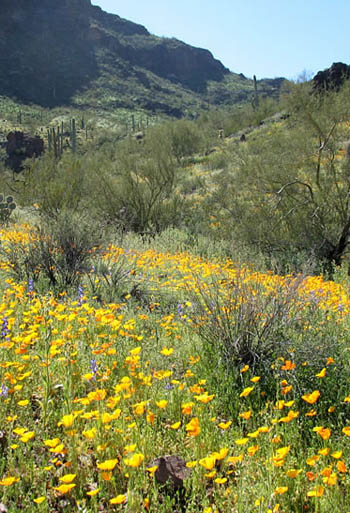THOMAS RAINER: THERE ARE NO MULCH CIRCLES IN THE FOREST
Instead of laying down a layer of mulch to separate plants, let native plants grow into beautiful, layered masses, said Thomas Rainer, ASLA, co-author of Planting in a Post-Wild World, at the Potomac Chapter of ASLA Gala in Washington, D.C. Rainer believes it’s possible to both boost biodiversity and achieve beauty through the use of “designed plant communities.” It’s possible to avoid creating a “weedy, looking mess,” but still harness the “adaptive ability of plants.” In fact, only by taking this approach can landscape architects and designers “reconstruct natural habitats in our cities,” which Rainer thinks should be their goal for the 21st century.
In the near future, Rainer sees a largely urban world dealing with the challenges of a changing climate. In the era of Anthropocene, there may be less pristine nature, which leaves cities and suburbs as a primary place to restore and reclaim ecosystems. “The loss of nature may represent a new beginning: an opportunity to re-wild our cities.” Rainer sees a future where skyscrapers have meadows, water treatment plants have wetlands, and highways are ecological.
So what’s holding all of this back? Rainer in part blames landscape architects and designers who are still pushing “formalistic arrangement of plants,” increasingly an anachronism in our world of biodiversity loss.
In a brief tour of landscape architecture history, Rainer explained that plants have long been used to “express order,” starting with the classical and French traditions. There was a pause in this approach with the English, pictureseque, naturalistic landscape style, which allowed for greater diversity of plant species. But that style lost favor amid the renewed formalism of Modernist landscape design, which “still dominates — with its mono-cultures of walls, carpets, stripes, and grids.” Modern formalism hasn’t been good for ecology. And while Rainer thinks that formalism may still have a place, more biodiversity must be introduced within this style.
All of those striking Modernist landscapes, and their contemporary variations, have had a “high impact on critters.” Birds rely on insects that rely on specific native plants. If you remove the plants from the equation, the whole ecosystem collapses. Today, “the lack of plant diversity is a real problem.” A way to introduce more diversity is through designed plant communities, which are “complex, adaptive systems” that require little maintenance. This new planting paradigm represents a shift from the Modernist approach of “plant as object” to a focus on “the power of systems.”
If landscape architects and designers are worried how all this will look, Rainer points out that the High Line, with its wild yet artfully-curated sets of plants, is one of the biggest draws in New York City. Rainer thinks this is because “there is nostalgia for the lost wild spaces,” and people want to see them in cities. But beyond the beauty of Piet Oudolf’s planting schemes on the High Line, those plant communities are also more resilient because they are more diverse. Oudolf let the plants “naturally interact.”

ASLA 2013 Professional General Design Honor Award. High Line, Part 2 / Mercer Country Master Gardeners
Sadly, too many landscape architects and designers still want to “mass, group, and separate” plants, instead of allowing the plants interact. One recent LEED Platinum building achieved all its site-related credits by planting the plaza out front with just one native plant, which seems to completely miss the point. There, “plants were treated like a piece of furniture.” But in the wild, “plants are social and react to changes in their network. If you take them out of their network, they lose functionality and resilience.”
As an example of the resilience of nature, Rainer pointed to a strip outside his house in Arlington, Virginia, which gets inundated with salt in the winter and dog pee year round, but has a diverse, inter-mingled mass of 26 different “weed” species.
Too many landscape architects and designers also bring in generic soils and mulch, to ensure that “anything will grow there,” as opposed to using available local resources to plant layered native communities, which really act as “green mulch.” As Rainer notes, “you won’t find mulch circles in the forest.”
Rainer said bringing in too much soil and mulch runs counter to increasing biodiversity. “It’s actually the lack of abundance of resources that leads to increased diversity. If you look at landscapes with a great deal of infertility like desert landscapes, that’s where you’ll see diversity, and a harmony of plants adapted to place.”
Biodiversity can look designed and be beautiful. “We can reach a new intersection between ecology and horticulture. We can combine the best of the ecological plant traditions with the pleasing dynamics of aesthetic formalism. We can avoid weedy messes, but also let plant communities self-seed and move around.”












Follow Us!